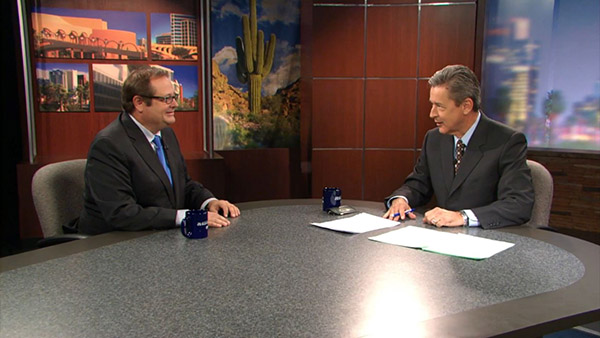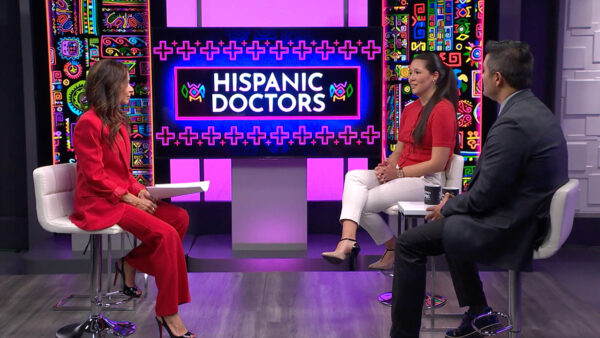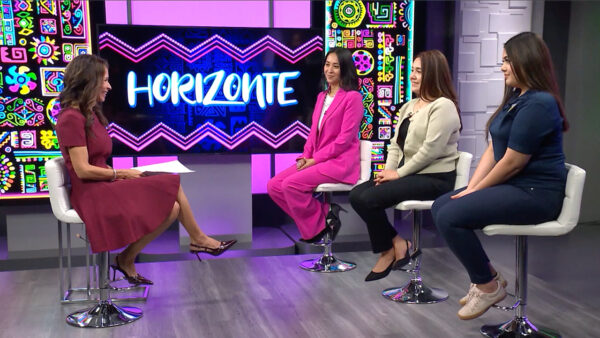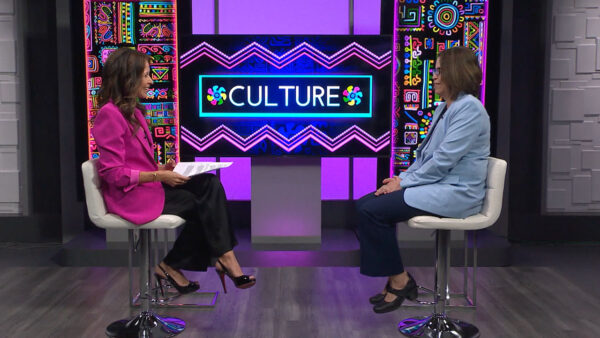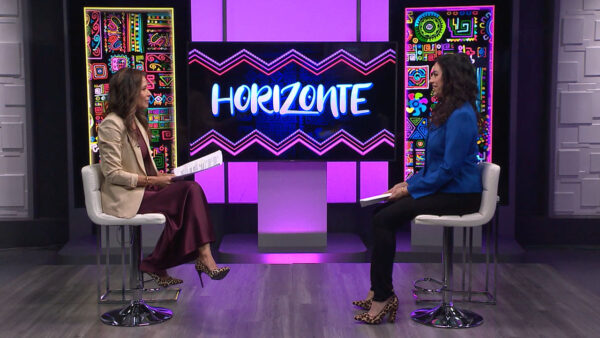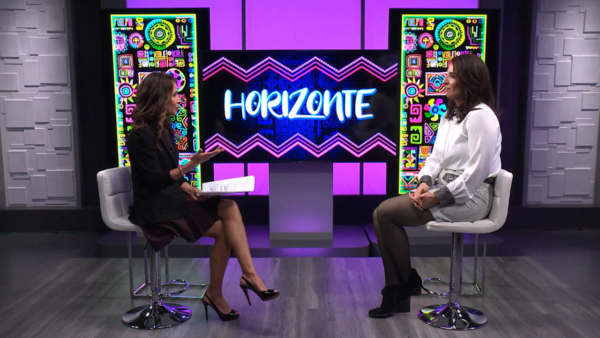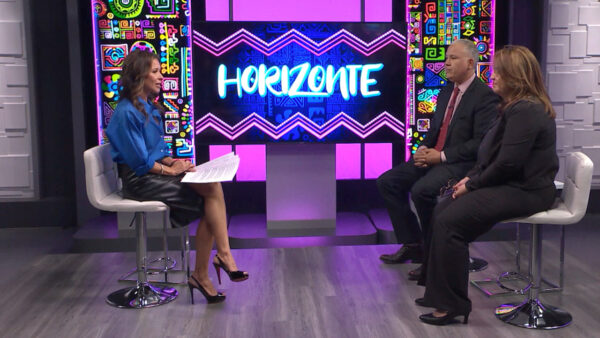El Dia de los Ninos is an event celebrated in more than 70 cities across the U.S. that honors all children, regardless of race, color or beliefs. “Celebrating Young Americans” is this year’s theme for the Phoenix event. HORIZONTE offers a perspective on what this day is all about.
José Cardenas:
Good evening and welcome to Horizonte, I'm José Cardenas. People across the country and here in the valley participated in an economic boycott and a day of nationwide demonstrations to support the need for immigration reform legislation. We'll talk about what took place and also the impact of current immigration laws. Plus, a unique festival that gives children, parents and teachers a chance to celebrate cultural awareness and the importance of education, a look at ‘Día de Los Niños'… all next on Horizonte. They called it "A Day Without Immigrants", demonstrators taking part in a work stoppage and economic boycott along with rallies and marches not only in Phoenix, but across the country. And as Nadine Arroyo explains, here in the valley, those demonstrations drew people from both sides of the immigration reform debate.
Protesters:
People united will never be divided. The people united will never be divided.
Nadine Arroyo:
A day without immigrants and many of them made their way to the streets for a call to action for fair immigration reform. No shopping, no working, no immigrants. These are illegal immigrants and citizens who believe that less is more.
Alfredo Gutierrez:
If you go to any store that treats the Hispanic community it's going to be empty. Construction after construction site is reporting to us that they're closed because they have insufficient workers. We don't have a report yet from the major resorts and hotels but I am absolutely certain people are going to be making their own bids today. So the magnitude is substantially greater it's just that it's not a march, not a demonstration, it's an even tougher thing to organize. It's an economic demonstration to everybody that we are everywhere and we contribute to this society in every aspect.
Nadine Arroyo:
The valley is one of more than 30 cities throughout the country taking part in the economic boycott. Organizers believe such a day will prove how instrumental immigrants are to the local and national economy and they want legislators to understand that this group of people is not about disturbing a process but about being part of a greater nation.
Francisco Heredia:
I was born here, but I come from a line of immigrant ancestry that came from Mexico and worked here. One of my grandparents came through a program and my aunts and uncles came here to work in the fields. All we want is to be here and work and support our families and to really be Americans.
Nadine Arroyo:
Hundreds of immigrants gathered in various valley home depot locations. Home depot because it's one of several areas where immigrants visit to get what they need to do their work. Margarita Quintanilla took the day off to lend her support to the cause. She says she's grateful for the 1986 amnesty, which helps her obtain her citizenship. She only has one thing to share with the people who don't believe she belongs here.
Margarita Quintanilla:
I love you, America.
Protest Opponent:
Speak English. You're in America. Speak English.
Nadine Arroyo:
Supporters of the game reform were not the only ones who made their way to the streets. Opponents also shared their views publicly.
Protest Opponent:
They're not born here. You ain't got a social security card? Go home. You weren't born in America? Go home. You can't speak English? Go home.
Protest Opponent:
Go back to Mexico. Go back to the Vicente Fox. Let them take care of your asses, we're tired of supporting you.
Chris:
They're doing more than I guess Americans are. I'm sure lots of them are Americans. But nobody else is going to stand out. I would give them credit for standing up for what they believe in. But the simple fact is that lots of them are illegal. So if here illegally then they have no right to say anything. My opinion.
Nadine Arroyo:
Organizers say that they are aware of the many here and throughout the country that are expressing their impatience on the events that have transpired in the past several months but they say they are not concerned about those who want to see them just go away but would rather focus on those who would be affected by what they claim are unfair and unjust illegal immigrant laws. They say it is about momentum and a much greater focus. The November elections.
Alfredo Gutierrez:
Our goal is to keep our people full of hope that there is one step forward after another. There are some people who say that. Perhaps too young to remember the civil rights movement. That in fact was the strategy, to keep people motivated and to demand justice until justice was accomplished. The voting rights act. In our case it's immigration reform and we're going to keep doing it.
Protester:
We got families. We're human.
José Cardenas:
Joining us now to talk more about the boycott and rally as well as the immigration issue are Daniel Gonzalez, reporter with the Arizona Republic, Jonathan Higuera, business writer also with the Arizona Republic, and Cecilia Menjívar. Associate Professor of Sociology, from the School of Social and Family Dynamics with ASU. Daniel, you first. In terms of just comparing the April 10th march with what we saw on May 1 and hear the comparison I'm looking for is just the format then we'll talk about the differences perhaps in tone.
Daniel Gonzalez:
Well, the main difference is that time April 10th march was a march and a rally where we saw anywhere between 100 and 250,000 people filling up probably three miles of boulevards in phoenix. So a massive out-pouring of people. The economic boycott and the work stoppage on Monday was a little bit of a different strategy. It was more intended to kind of hit people in the pocketbooks to send a message of the contributions undocumented immigrants and immigrants as well make to the United States.
José Cardenas:
Jonathan, in terms of levels of participation. Any sense with whether -- and I realize it's hard to counts the number of people who didn't go to work -- but any sense whether this was less well supported by the immigrant community and their supporters than the April 10 demonstration was?
Jonathan Higuera:
That is the sense that I got, that there were some mixed messages going out among the organizers on whether one should go to work or not go to work or go to school and not go to school. You saw some of that among the organizers who disagreed on that. I think that may have had an impact on some people's decisions on whether to stay home from work or school. And in fact we talked to a number of employers who said, you know, I talked it over with my employees and found that a lot of them did choose to stay -- did choose to go to work, rather. But in many cases the employers were really on alert and were really being pro-active in trying to get a sense of who was coming and who wasn't.
José Cardenas:
Professor, my sense from watching the national newscast was that there was a lot more attention paid to the May 1 activities than April 10 and it seemed to at least in some other cities you had the opposite of what Jonathan was talk about here in Phoenix, much greater participation, big crowds, half a million in some of these big cities. What's your sense of the difference between support in phoenix and those other cities?
Cecilia Menjívar:
Yes. I think there was more participation in other cities where the organization and the leadership were more in agreement on what was expected to happen on that day than here in Phoenix.
José Cardenas:
Here in Phoenix we did have preliminary airline, at least, some differences of opinion about what to do. You think that impacted the ultimate support?
Cecilia Menjívar:
Right, it might have. Also some might have been more afraid to participate on May 1 because they might have been more afraid to lose their jobs maybe. Here in Phoenix than maybe in California.
Daniel Gonzalez:
I think there was something else, though, that was going on. There was some very significant marches that took place that we had here in Phoenix, March 24 and Los Angeles and also had some major march on March 25. And there was -- I think people saw those marches including people in phoenix and said they really wanted to get on board then we saw kind of the big marches take place in Phoenix, Washington D.C., a number of other cities on April 10. But Los Angeles, as you will recall, didn't have a big march on April 10 and neither did Chicago. And I think folks in those cities felt kind of left out by what happened on April 10 and they really kind of came out and were energized to come out on May 1. So I think we kind of saw kind of this movement snowballing across the country and going from city to city. And that's really why you saw big marches in cities on may 1 that you didn't see so much on April 10.
José Cardenas:
Is it your sense, Daniel, that at least on a nationwide basis overall this was a successful effort?
Daniel Gonzalez:
I think it was successful in the terms of the sheer size and keeping the issue of immigration and reform in the public's eyes.
José Cardenas:
Professor, you have done work with respect to families and the impact of immigration on them.
Cecilia Menjívar:
Right.
José Cardenas:
One statistic I heard was as many as 7,000 high school students in the phoenix high school district didn't show up on Monday. That's about a third of their student population. Any thoughts about that?
Cecilia Menjívar:
I do probably feel that they have to go out and not only support their parents but themselves. Because I suppose they live in what we call mixed familying, -- families, families that have mixed legal status where one parent may be undocumented and one parent a permanent resident, one child born in the united states and one child born outside of the united states. So you have this phenomenon of mixed families occurring very often. So they probably felt like they needed to support the siblings and the parents, if not themselves.
José Cardenas:
Jonathan, you heard on the video package the leader of these efforts pretty confident that there would be a lot of people making their own beds at the resorts. What's your assessment of the actual impact on the labor situation?
Jonathan Higuera:
Well, that's not the reports we got coming from the hotels and the resorts. Quite frankly when we called they were saying it was pretty close to business as usual. But once you got past that first response, what you also heard is that they were very pro-active in working with their employees to find out who wanted to come in and who wanted to stay home and support the boycott. So they scheduled around it. They were much more prepared with policies on how to deal with absences. A lot of them had yes, you can take a day off but it is on a first come, first served basis. Then they had cutoff levels where people who wanted to take a day off after that could not. So I think they were much better prepared. They got a lot better advice from the employment attorneys that advised them on how to deal with this. And so we didn't see the impact there. But I would say of the construction sites that I visited there was a dramatic impact there and you did see work sites that were pretty much idle or really just, you know, barely keeping operations running. But the nature of that industry is different than homes and restaurants. That industry deals a lot with the high turnover and just days when there's not a lot of production. So they kind of keep moving forward. It was certainly a set back but when it takes five to six months to build a house, you can afford a day of slow or no production when you're serving customers at a restaurant or in a hotel, it's a different situation. It's a point of service business that you have to be prepared for.
José Cardenas:
Now, the other part of the economic boycott was in addition to staying home, don't shop. Any sense for how successful that tactic was?
Jonathan Higuera:
That was tough to get a handle on. But we had a lot of people tell us, well, traffic was much lighter on the freeway if that's any gauge. But in terms of the actual traffic at major retailers, none of us told us it had a discernable impact. Wal-Mart -- we talked to Wal-Mart officials, we talked to Costco officials. They did say they might have had some impact at certain stores in certain neighborhoods but in general there was no discernable decrease in sales, which also may have been part of the counter protest where people went out and bought heavily to kind of counter act this boycott. So that might have had an effect, too.
José Cardenas:
Daniel, any other kinds of backlash that you may have noticed? And Jonathan just suggested that one of them may have been people kind of affirmatively supporting retailers for example -- for example. But what other consequences in terms of backlash have you noticed?
Daniel Gonzalez:
I think what folks are seeing is kind of a hardening of positions on both sides of the issue where you have people who might have already had strong feelings against illegal immigration have really been hardened in their stances. And it might have also -- I think some folks have been turned off by, especially seeing, the Mexican flag being waved and also people staying home and being inconvenienced and disruptions that we saw in commerce. I think that's kind of been a turnoff for some people. There was a poll done here at ASU I think last week before the economic boycott that showed that up until then, at least, the marches and the rallies had elicited more bad feelings than good feelings. I think, though, there's something really notable here. And what we're seeing in this movement is that the organizers are trying out different strategies. The April 10 marches were people were really focusing on putting a face on illegal immigration, showing families and children and trying to put a positive look to the issue of immigration. And I think what may first really signify it is that folks are starting to say, well, do we need to take kind of a more aggressive, radical approach to this movement. That's what people are kind of wondering. Are we kind of seeing the movement take a turn here and to kind of a more radical, more aggressive approach? That still remains to be seen. But that's really what may 1 I think was different than the early marches were. The organizers, there was a lot more division and they were kind of testing out some different strategies on how to keep the issue of comprehensive immigration reform in the public's eye and keep pressure on congress to get something done.
José Cardenas:
Professor, let's talk about the legislation that seems to be at the root of a lot of this. You studied this, particularly the 1996 reforms. People, though, seem to focus more on 1986 and the amnesty provisions there. But I think your study has shown that '96 may actually have had more of an impact. Tell us about that.
Cecilia Menjívar:
Right. The 1986 immigration act it created more categories for exclusion, basically, more categories to penalize not only undocumented immigrants but legal immigrants who are now deportable if they have certain crimes for which they have been sentenced for a year or longer in prison. But that law also created more possibilities for exclusion for undocumented immigrants, for those who come and overstay their visas as well as those who cross the border.
José Cardenas:
So overall it was a toughening or tightening.
Cecilia Menjívar:
Exactly. It is the stiffest immigration law that has everybody been passed.
José Cardenas:
What was the consequence of that?
Cecilia Menjívar:
One of the consequences is that it has separated families quite a bit. Parents and children have been separated sometimes one parent has been deported or has been barred from entry. And so that creates conditions for people to migrate -- my great without documents because they want to be with their families. So that's what the results of the 1996 act and not a lot of people pay attention to that.
José Cardenas:
Did that in fact have the way of -- stimulating --
Cecilia Menjívar:
That is coupled with more border enforcement. We know that more border enforcement in the 1996 act, which included stipulations for more border enforcement has created several effects. One is the increase of undocumented population in the country. The other one is the instance of deaths at the border, of course. The other one is the less likelihood of being apprehended while crossing the border. Because in more rugged terrain it's more difficult for border patrol to apprehend people. So it has created conditions for people to remain here and not engage in seasonal immigration and for those who are separated because of the 1996 law to want to be together and therefore cross the border.
José Cardenas:
Now, one of the criticisms of the proposals such as the McCain-Kennedy bill which would provide for guest workers and provide a path to legalization is that that's unfair, that's basically amnesty. Describe the process that exists now for somebody who wants to apply for legalization.
Cecilia Menjívar:
Right. To go from being undocumented to being a citizen, are you a citizen; it takes at least from 15 to 20-years. It's not an overnight process. The service side of the immigration agency is heavily burdened with processing of those applications. So, for instance, someone applies for a work permit or for permanent legal residence. That takes several years to process. From being a permanent legal resident to becoming an U.S. citizen it takes five years to wait, just to wait for permission to apply. If you're married to an U.S. citizen it takes three years just to wait to apply. From there it takes about from 5 to 10-years to actually become a U.S. citizen.
José Cardenas:
That's because there are so many people and so little resources to process the applications?
Cecilia Menjívar:
Right. So a lot of people -- we have paid so much attention to border enforcement and employer sanctions. But I think where the attention also needs to go is to the service side of the immigration -- of immigration services. The processes -- processing of applications.
José Cardenas:
Before we came on the air you said it can be as much as two years just to process a change of address?
Cecilia Menjívar:
Exactly. So for instance I have interviewed many immigrants who are afraid to move from one house to another because they don't want to lose a permit that they get in the mail because it takes two years, at least two years for just a change of address to be processed. Some who applied in 1998 -- 1998 are still waiting for those applications to be working.
José Cardenas:
Seven years later they're still waiting.
José Cardenas:
Let me ask you this. One of the things that was mentioned in the reports was the involvement of other groups which are of immigrant decent, Irish-American and so forth. What's your take on that?
Daniel Gonzalez:
I think that was definitely what you say in -- saw in cities like Los Angeles and especially Chicago where you have a very cosmopolitan city with immigrants from all over the world. And it showed that this movement is not just a Latino movement, it's a movement made up of many other groups who are affected by the nation's broken immigration system and who are out there who have been mobilized to try and bring about some change.
José Cardenas:
Jonathan, you indicated that maybe employers are losing patience? If we see another boycott coming what do you anticipate would be the reaction from the business community?
Jonathan Higuera:
Well, let me first say I didn't add earlier that we did see widespread support among the mom and pop businesses, mostly Latino-owned that serve those immigrant communities. That's where I think you really did see a lot of closures and a lot of support. I want to mention that since I may not have mentioned it earlier.
José Cardenas:
About 30 seconds.
Jonathan Higuera:
But in terms of the employers and what's going on with them, I interviewed a lot of employers who the first time around closed their businesses and marched with employees and took the hit in stride and said, this isn't about money. This is about humans when way came back to talk to them a second time around they were much less supportive but still walking a fine line.
José Cardenas:
We're going to have to leave it all there for the moment. Thank you all for joining us.
José Cardenas:
The Dia de Los Niños festival was originally created to introduce children to artistic expression. Education and sports activities, food and entertainment. The festival now in its ninth year in phoenix has become an event that celebrates all children regardless of race, color or belief. More than 70 cities in the United States celebrate this tradition. Merry Lucero brings us this year's Dia de Los Niños festival.
Merry Lucero:
The booths at -- at the 2006 festival had all the activities that kids love. Face painting, crafts and sports. The holiday is all about children.
Carmela Ramirez:
And our whole focus really is to celebrate children. Dia de Los Niños means day of the child. It started in Mexico and made its way over here to the United States.
Merry Lucero:
But in addition to having fun, the event's goal is to teach awareness of Hispanic heritage and cultures of all nations.
Carmela Ramirez:
And what we really center in on is cultural education, to make sure that children really understand that this is a beautiful melting pot that we have here in the United States. No longer are we just one ethnicity anymore.
Merry Lucero:
Teachers brought their students to learn about ethnic customs and traditions.
Rebecca Thuer:
We celebrate multicultural have the kids come out and learn about different cultures, Hispanic culture and anything that was out here.
Steven Marr:
I learned the Spanish culture a little bit. And I found it kind of interesting.
Jorge Padilla:
We had fun. I'm already Mexican and American so I already know about it.
Merry Lucero:
Another part of the festival at Margaret Teehan's park in Phoenix, entertainment like the colorful dancers of the ballet folklore. It also offers opportunities to get across important health and safety messages.
Parent:
Good job.
"Fire Pal Dave":
Here we're able to reach so, so many kids that -- it's a home run here. We're installing smoke alarms to make sure the kids know how to check them how they get out of their house, learn escape plans and obviously to make sure they understand to never ever use tobacco products.
Merry Lucero:
Blue Cross Blue Shield did onsite children's health screenings.
Alex Arredondo:
Children's health is a very important issue especially with obesity and other health problems. So this gives us an opportunity to provide some health screens at this event that is primarily for the kids to have fun but also to get information so we provide the health screenings on top of the other things that are going on here at this event.
Merry Lucero:
And another main message of the festival, the importance of education.
Carmela Ramirez:
We have to drive the kids to get the best education that they can and there are so many educational resources here. Every single booth has an interactive activity. It could be just building a costume for yourself, a nice hat, or it could be building your own brain. From the ASU Village. So there's so much. But it is really celebrating cultural diversity, education and just children in general which is our -- that's our most precious commodity. That's what we're all about.
José Cardenas:
For more information on upcoming shows or shows that have already aired, please visit our website at azpbs.org and click on Horizonte. That's all tonight for Horizonte. I'm José Cardenas for all of us here at Horizonte have a good evening.
Jonathan Higuera: Business writer, Arizona Republic;
